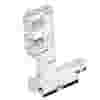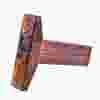Threaded holes provide versatility, leak prevention, and customization not only within plastic manifold design but other custom plastic products as well. This guide's chapter outlines critical considerations for threading, including material selection, thread sizing, and techniques to prevent stress cracking, ensuring optimal manifold performance.
Stop Wasting Time on Trial-and-Error Designs
WHY THREADED HOLES MATTER IN PLASTIC MANIFOLD DESIGN
Threaded holes enable the attachment of components, fittings, and accessories, allowing for customized manifold applications.
LEAK PREVENTIONProper threading ensures secure and tight connections that reduces leak risks. In harsh use cases, this aspect is a non-negotiable.
CUSTOMIZATIONDifferent thread sizes, depths, and types cater to specialized requirements, enhancing functionality.

HOW TO CHOOSE THE RIGHT THREADING
The right threading matters. We have the following points to consider before making a decision.
- Select the right material for the job
- Choose materials compatible with your application's mechanical and chemical requirements. If you're having trouble figuring out which is best, consult with our experienced engineers to find the right resin or material to get the job done right.
- Choose the right thread size & pitch
- This crucial step works to ensure a leak-free, tight, and secure connection to the other parts of your assembly. Understanding the application's pressure and flow requirements is crucial.
- Know the threat standards in your industry
- Familiarize yourself with industry standards to ensure compatibility with fittings and accessories. Questions? Feel free to book a consultation with our staff for some guidance.
DESIGN TIP
Prevent Stress Cracking From Over-tightened Threads
We'll cover this more later, but be aware that applying the proper amount of torque on a fitting, fastener, or component is critical to avoid damaging the part. Over-tightening can lead to stress cracking, often visible at the deepest thread. Additionally, avoid using anaerobic compounds like Loctite for fastener retention, as they can also cause stress-cracking in plastics.
UNDERSTANDING STRESS-SENSITIVE PLASTICS
In the materials world, we commonly refer to two types of plastics: stress-sensitive and not stress-sensitive (or stress-insensitive). Stress-sensitive plastics will be more likely to experience cracking and breaking under load. Majority of cases are with threaded fasteners where others have accidently over-torqued. Stress-insensitive can take more force than their more sensitive siblings.
Amorphous thermoplastics are often more stress sensitive than semi-crystalline and fully-crystalline thermoplastics. Most amorphous thermoplastics are identified by their clarity while semi-crystalline and fully-crystalline thermoplastics are opaque.
To assist in further understanding, we have categorized those plastics here.
| STRESS-SENSITIVE PLASTICS | NOT STRESS-SENSITIVE PLASTICS |
|---|---|
| Acrylic Polycarbonate ULTEM® COP COC Radel Polysulfone Noryl | Delrin (acetal) PEEK PPS PET PBT ABS* Teflon® Nylon Polypropylene CTFE HDPE PVC* CPVC* |
*These plastics, while non-stress sensitive, are amorphous
DESIGN TIP
Concerning Maintenance
Use a torque wrench for tightening and ensure proper tightening technique. Here is our recommended chart for reference about the recommended tightening torque in plastics without inserts.
| Size | Torque (Imperial) | Torque (Metric) |
|---|---|---|
| 6-40 | 1-1.3 in*lbs | 0.11-0.15 N*m |
| 10-32 | 2-4 in*lbs | 0.23-0.45 N*m |
| ¼-28 | 2-4 in*lbs | 0.23-0.45 N*m |
| 1.6mm | 12 in*oz | 0.085 N*m |
| 2mm | 18 in*oz | 0.13 N*m |
| 2.5mm | 24 in*oz | 0.17 N*m |
| 3mm | 30 in*oz | 0.21 N*m |
| 0-80 | 12 in*oz | 0.085 N*m |
| 2-56 | 24 in*oz | 0.17 N*m |
| 4-40 | 30 in*oz | 0.21 N*m |
| 7/16-14 | 20 in*lbs | 2.3 N*m |
THREADED HOLE TYPES & HARDWARE OPTIONS
When speaking to threaded holes within plastic manifolds, our experts have stated it's important to know the differences between machined threaded, inserts, and helicoils.
Machine Threaded
For applications where the assembly happens only once, fully machined threads are a great choice for several reasons. Many often cite the versatility of this option over others. Machined threading offers maximum flexibility on thread length and thread size as well as material choices. There are few resins that do not take machined threading well. Moreover, designers have more free range with machine threading as it makes more room for special threading if the product requires.
Also, out of the other possible options, they usually come out as one of the most cost efficient options. It often does not require extensive work to create such holes within a device compared to other techniques.
We do want to be clear about a few matters here. Stress sensitive plastics require good machining technique. It does require a certain amount of skill to thread these without inducing stress on the overall manifold. We also do not recommend machined threading for repeated assembly/disassembly as this can wear out the threads that much faster. We recommend a different approach for those that need that feature.
As with most techniques, we have some design suggestions to bear in mind when considering machined threading as an option.
- The threads should have a minimum 3x thread-to-diameter engagement.
- Any threaded holds smaller than #2 or 2mm threads have limited pullout strength. It's best to consider other options.
- Pipe threads are ok in non-stress sensitive plastics such as Delrin.

Press-In Inserts
Press-in inserts (PIIs) offer similar advantages as the others, but these specialized inserts require mechanical force to place. Due to this, these tend to add stress to the plastic manifold and should only be used in semi-crystalline plastics, such as fluoropolymers (e.g. Teflon) and thermosets (e.g. G10). Moreover, these come in limited choices in thread length and offer limited pull-out strength. If the assembly needs repeated disassembly, we recommend an alternative more suited to the product's purpose.
With these, pipe threading is possible. They consist of same materials as their other counterparts: brass and stainless steel in common thread sizes with the ability to insert NPT threaded inserts thermally.
DESIGN TIP
On Valves & Press-in Inserts
For small valves, the mounting holes are often close together. Inserts cannot be used due to the heat affected zone. Machined threads for small valves are acceptable as long as the tightening torques are managed properly.
Helicoils
While Helicoils are common in metal machining to improve thread strength, they are not used in many applications for plastics due to several limitations. Cost factors as one of those top limitations. It often comes out as one of the most expensive options because (depending on size) these can add an extra $2-$4 per hole in each manifold. Those costs add up quickly.
Why so expensive? Helicoils have marked themselves as time-consuming and difficult to insert — particularly for smaller holes. Moreover, there is an inherently higher risk of damage when installing in a threaded hole, which limits even which plastic materials would take Helicoils. We recommend that if using Helicoils to avoid any stress-sensitive plastics as they add more mechanical stress to the manifold.
All that said, Helicoils do have some advantages. If the product needs taking apart and putting together on a regular basis, these offer that feature with security. We recommend them for non-stress sensitive plastics and thermosets as they can take the mechanical stress involved when installing as well as future assembly/disassembly. These also work well in small places near other features. Pipe threads are also possible here.
Regarding tanged vs. tangless helicoils, we have seen that designers tend to prefer tanged over tangless as the installation tools are less expensive and more robust. If tang removal is required, designers then often choose tangless.
Design Smarter, Build Stronger
INSERTS & HARDWARE
Metal inserts find use in applications where a designer plans that a product will be repeatedly disassembled or need maximum pull out strength. With metal inserts, our operators usually perform this task either by staking (ultrasonic or thermal) or pressing. If the product needs an insert but space is constrained, we recommend selecting Helicoils, as they are more compact and ready to serve in that function. However, do not use Helicoils in stress-sensitive plastics. Threads will begin to propagate stress-cracking over time and result in the component’s premature end.
Inserts can offer some advantages that neither machined threading or self-tapping screws can. For example, unlike self-tapping screws, inserts work well with stress-sensitive plastics (e.g. SMPs and ER polymers) and excellent pullout strength. We also recommend these for threads below #2 or 2mm, as they can accommodate the smaller sizes without much issue and offer pipe threading as an option.
Some barriers do stand regarding inserts. For one, manufacturers can only offer limited choices for thread length. They are not meant for deep perforation, and designers should consider other options if their product needs this feature. Additionally, when constructing the manifold with inserts, the machinist needs to have some skill as they need to know how to manage the liquid plastic flow. Without this knowledge the inserts and the manifold could suffer threats to their structural integrity.
INSERT MATERIAL
For inserts in plastic manifolds, we recommend two different materials for use here: stainless steel and brass. While these cover the common thread sizes, each has their advantages and disadvantages independent of those thread sizes. These need careful consideration from the designers to decide which would be best suited to the product.
Stainless steel inserts feature chemical resistance, which has designers' favor over their brass counterparts. Usually, these steel inserts resist many different chemical types, including harsh corrosives. They have added strength and durability when the component needs that feature.
However, we must note that steel inserts often take more time to assemble with heat staking, which can drive up their initial cost. We urge designers to keep this in mind if considering these for manifolds.
Brass inserts usually cost less initially. If a component does not need staunch chemical resistance or added strength, brass inserts can offer a fair compromise. However, if a designer is looking for something RoHS compliant, they may need to seek another option as some brass inserts contain lead.
METHODS FOR INSERTING METAL THREADING INTO PLASTIC MANIFOLDS
ULTRASONIC STAKING
Using soundwaves instead of heat, machinists install inserts this route to avoid high temperatures that could alter the component's integrity. This method works great for high quantity orders.
THERMAL STAKING
Using higher temperatures, machinists heat the metal inserts hot enough to melt the inserts immediate area within a manifold. That insert then melts and "glues" itself into the manifold, creating a flush surface and design. This method works better for smaller quantities.
PRESSING
Pressing often implies a more mechanical way of embedding metal inserts into plastic manifolds using force. Yet we strongly caution against cold-pressing as it is generally only good for pins or half-cartridge type fittings.

DESIGN TIP
On Heat Affected Zones In Manifold-Insert Construction
As staked inserts melt the plastic around the insert, there is a zone where any features cannot be placed. Insert must be a full diameter away from an edge to avoid sidewall bulge.
.jpg?format=pjpeg&width=100&quality=10)